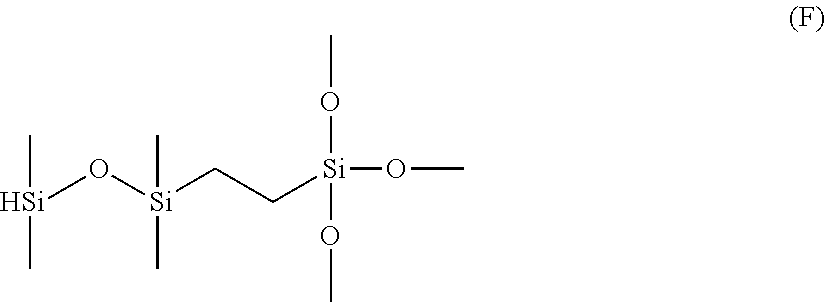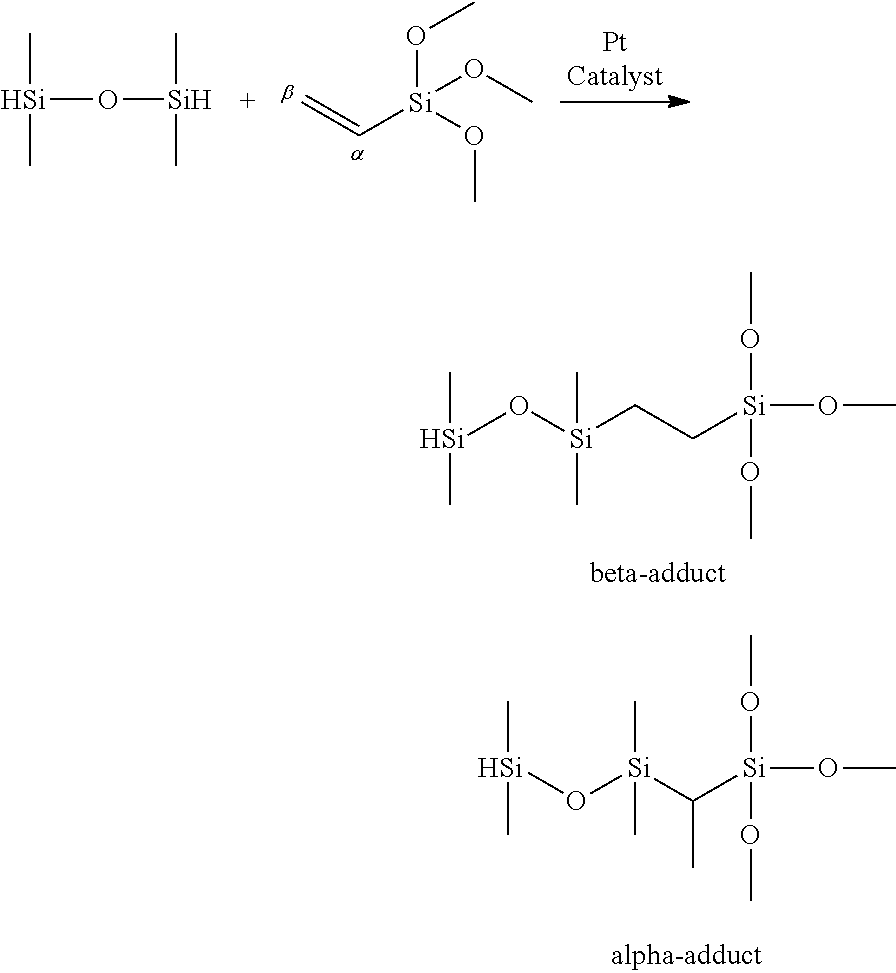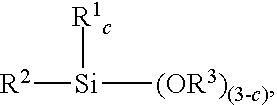Method for hydrosilylation of aliphatically unsaturated alkoxysilanes and hydrogen terminated organosiloxane oligomers to prepare alkoxysilyl terminated polymers useful for functionalizing polyorganosiloxanes using a rhodium catalyst
a technology of hydrogen-terminated organosiloxane and hydrosilylation method, which is applied in the direction of organic compound/hydride/coordination complex catalyst, physical/chemical process catalyst, chemical apparatus and processes, etc., can solve the 65/35 mole ratio of -adduct/-adduct, process inefficiency, and the need to recover relatively large amounts of unreacted 1,1,3,3-tetramethyldisiloxan
- Summary
- Abstract
- Description
- Claims
- Application Information
AI Technical Summary
Benefits of technology
Problems solved by technology
Method used
Image
Examples
example 1
[0105]A 250 mL round bottom flask containing a stirbar was loaded with 80 g of TMDS, and to it was affixed an addition funnel containing 82.77 g of VTMS. The apparatus was thoroughly purged with nitrogen and then pre-heated to 50° C. A steady addition of the VTMS was initiated (1 drop / sec) and then 2.38 mL of a 0.005 M solution of [Rh(dppe)Cl]2 in THF was added. The addition was continued at such a rate that the reaction mixture temperature did not exceed 70° C. after the first 50% of VTMS was added, and then 80° C. for the second half of the addition. Following the addition, the reaction mixture was allowed to react for 16 h at 80° C. The reaction mixture was then purified by vacuum distillation, which resulted in a light fraction (solvents, unreacted reagents, and light byproducts), a desired product fraction (approximately distilling at 1.25 Torr (0.1666 kPa) and 55-60° C.), and a heavy fraction which was left behind in the distillation flask. The yield of the desired product fra...
example 3 (comparative)
methoxysilyl-Terminated Tetramethyldisiloxane
[0107]In an air-free glovebox, a mixture of 1.1 g of VTMS, 1 g of TMDS, and 0.25 g of dodecane (internal standard) was added to a 20 mL scintillation vial containing a stirbar. Then 30 μL of a 0.01 M solution of Pt in THF in the form of Karstedt's catalyst (supplied as 2% in xylene, Sigma Aldrich) was added (this reagent solution was heated to 60° C. with stirring in order to dissolve the poorly soluble catalyst). After stirring at room temperature for 30 min, the reaction mixture was heated to 50° C. for 16 h. At this stage, an aliquot (150 μL) of the reaction mixture was withdrawn and injected into a GC vial, and diluted with 1 mL of xylene. The reaction was analyzed by GC-FID and GC-MS. Analysis indicated 72% overall yield of the ETM products, with a selectivity ratio of 64:36 of the linear: branched isomers. A small amount of unreacted tetramethyldisiloxane was observed but all of the vinyltrimethoxysilane was observed.
example 5
[0110]A rhodium diphosphine catalyst, [Rh 1,2-bis(diphenylphosphino)ethane Cl]2 was dissolved in THF to prepare a 1 millimolar (mM) catalyst solution. A three-neck round bottom flask fitted with a thermocouple and a cold water condenser was charged with 9.96 g M′D′M′ and 15.04 g VTM. The flask was purged with N2, and the mixture in the flask was heated to 80° C., followed by the addition of [Rh(dppe)Cl]2 solution (1 mL). A slight exotherm was observed, with the temperature elevated to 96° C. within 5 minutes of addition. After 17 h stirring at 80° C. under N2, the reaction mixture was allowed to cool to room temperature of 25° C. and analyzed by GC which showed it contained 13% monofunctional oligomer, 63% difunctional oligomer, and 12% trifunctional oligomer. The sample was purified by distillation under 1 Torr (0.1333 kPa) to generate 14.4 g difunctional oligomer product (yield: 57%) that was characterized by GC, 1H, and 29Si NMR. According to 1H NMR, this oligomer was composed of...
PUM
| Property | Measurement | Unit |
|---|---|---|
| pressure | aaaaa | aaaaa |
| temperature | aaaaa | aaaaa |
| temperature | aaaaa | aaaaa |
Abstract
Description
Claims
Application Information
 Login to View More
Login to View More - R&D Engineer
- R&D Manager
- IP Professional
- Industry Leading Data Capabilities
- Powerful AI technology
- Patent DNA Extraction
Browse by: Latest US Patents, China's latest patents, Technical Efficacy Thesaurus, Application Domain, Technology Topic, Popular Technical Reports.
© 2024 PatSnap. All rights reserved.Legal|Privacy policy|Modern Slavery Act Transparency Statement|Sitemap|About US| Contact US: help@patsnap.com










